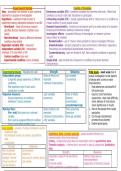Summary
AQA Psychology 1st & 2nd year research methods summary - By A* student
- Course
- Institution
A complete revision summary of the AQA A level psychology topic Research Methods for both 1st and 2nd year. Covering all the bullet points made on the AQA specification for AO1. Also includes AO3 for each of these points. Made by a student who achieved A* in their A level.
[Show more]



